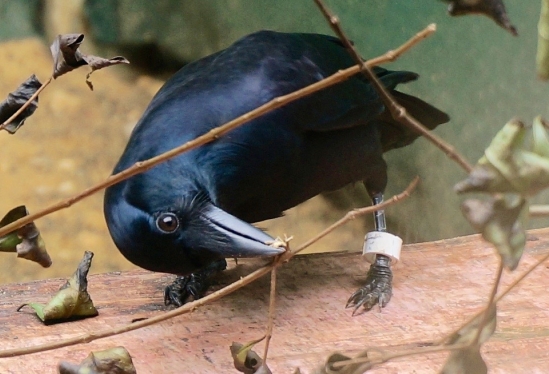Footage from a revolutionary behavioural experiment showed non-primates making and using tools just like humans. In the video, a crow is trying to get food out of a narrow vessel, but its beak is too short for it to reach through the container. Nearby, the researchers placed a straight wire, which the crow bent against a nearby surface into a hook. Then, holding the hook in its beak, it fished the food from the bottle.
Corvids—the family of birds that includes crows, ravens, rooks, jackdaws, and jays—are pretty smart overall. Although not to the level of parrots and cockatoos, ravens can also mimic human speech. They also have a highly developed system of communication and are believed to be among the most intelligent non-primate animals in existence.
McGill Professor Andrew Reisner recalls meeting a graduate student studying corvid intelligence at Oxford University when these results were first published in 2015.
“I had read early in the year that some crows had been observed making tools, and I mentioned this to him,” Reisner explained. “He said that he knew about that, as it had been he who had first observed it happening. Evidently the graduate students took turns watching the ‘bird box,’ […] and the tool making first occurred there on his shift.”
One of the biggest milestones in intelligence not strictly related to ‘smarts’ is self-awareness and self-recognition. If an individual creature is sentient enough to comprehend itself as an entity and understand the implications, scientists can consider it sentient on a higher level than creatures that, however clever, have no sense of self.
One popular method to test this is called the ‘Mirror Test,’ which attempts to analyze animals’ behaviour when faced with their own reflection, to determine whether they interpret the image as another animal or if the image is understood as a representation of the original.
A number of animals have been observed interacting with their reflection in such a way that scientists believe they have a true sense of self—among them a few different birds, including the magpie (Pica pica). This means different things for different animals: In the case of the magpies, birds were shown to be able to identify the location of a dot placed on them when they were able to see themselves in a mirror, but not by touch or when the dot was of the same color as their feathers.
This test is not perfect—among its criticisms is that it tests only a limited and specific set of conditions. For example, dogs rely primarily on smell and hearing, with much less sensory input coming from vision, so they may process the data differently.
The use of tools is another important marker for intelligence. Very few animals can commandeer resources from their environment, using specially shaped rocks or sticks as extensions of the body in order to complete an otherwise impossible task. It is considered one of the major steps in human evolution, but has now been observed in a number of other species—mainly primates—but also elephants, dolphins, and some octopuses.
A variety of birds have been recorded using tools, including woodpeckers and Egyptian vultures; however, only one family of animals has also been known to do something no other animal, other than a human has ever been known to do: Manufacture their own tools. In the study related at the beginning of this article, New Caledonian crows (Corvus moneduloides) were shown to be able to adapt elements of their environment into tools they could then use—for example, bending a length of wire into a long hook of just the right shape to free a morsel of food from a closed container.
McGill University has its own place in the history of animal intelligence, as well. Dr. T Wesley Mills, a turn-of-the-century McGill physiologist, wrote a book on the subject: The Nature and Development of Animal Intelligence (1898). A century later, our university is still a hotspot for new developments.
McGill’s Bellairs Research Institute in Barbados just published a study detailing a dramatic difference in intelligence between rural and urban birds, indicating that city birds, who spend most of their lives around humans and human activity, pick up some street smarts from their environment. Some of which include boosted immunity and problem-solving skills, which usually do not correlate.
“We assumed that you can’t be good at everything,” Jean-Nicolas Audet, one of the authors of the study in the journal Behavioral Ecology said. “It seems that in this case, the urban birds [do] have it all.”
Further study is always being carried out at the McGill biology department’s Lefebvre laboratory. Professor Louis Lefebvre has also studied bird intelligence extensively, and has determined the Japanese carrion crow (Corvus corone) to be the smartest he’s studied. Since 1994, Lefebvre and his students have studied over 500 distinct species of birds, with a special eye toward remarkable learning innovations in feeding patterns. This includes how tits, a type of bird, have been observed learning how to open milk bottles. He’s also studied how crows in cities with traffic lights have learned to interpret the light colour as a signal of precisely where and when to drop nuts on the crosswalk so that they will be cracked by automobiles and also when it is safe to retrieve them afterward.
2,500 years ago, the Greek storyteller Aesop observed the fascinatingly intelligent feeding patterns of birds, especially crows. Today, these birds continue to show that they’re a lot smarter than we tend to give them credit for.






